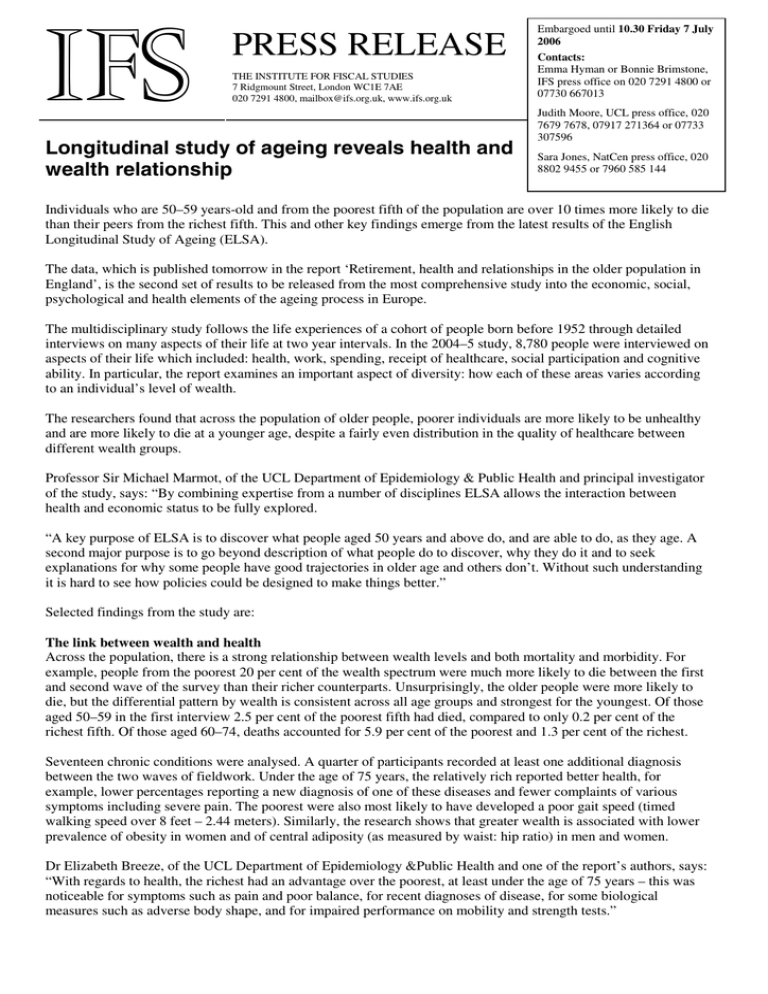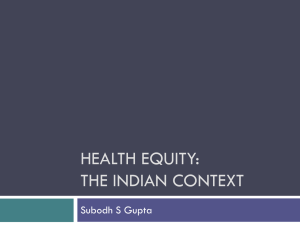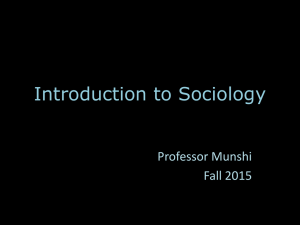IFS PRESS RELEASE
advertisement

IFS PRESS RELEASE THE INSTITUTE FOR FISCAL STUDIES 7 Ridgmount Street, London WC1E 7AE 020 7291 4800, mailbox@ifs.org.uk, www.ifs.org.uk Longitudinal study of ageing reveals health and wealth relationship Embargoed until 10.30 Friday 7 July 2006 Contacts: Emma Hyman or Bonnie Brimstone, IFS press office on 020 7291 4800 or 07730 667013 Judith Moore, UCL press office, 020 7679 7678, 07917 271364 or 07733 307596 Sara Jones, NatCen press office, 020 8802 9455 or 7960 585 144 Individuals who are 50–59 years-old and from the poorest fifth of the population are over 10 times more likely to die than their peers from the richest fifth. This and other key findings emerge from the latest results of the English Longitudinal Study of Ageing (ELSA). The data, which is published tomorrow in the report ‘Retirement, health and relationships in the older population in England’, is the second set of results to be released from the most comprehensive study into the economic, social, psychological and health elements of the ageing process in Europe. The multidisciplinary study follows the life experiences of a cohort of people born before 1952 through detailed interviews on many aspects of their life at two year intervals. In the 2004–5 study, 8,780 people were interviewed on aspects of their life which included: health, work, spending, receipt of healthcare, social participation and cognitive ability. In particular, the report examines an important aspect of diversity: how each of these areas varies according to an individual’s level of wealth. The researchers found that across the population of older people, poorer individuals are more likely to be unhealthy and are more likely to die at a younger age, despite a fairly even distribution in the quality of healthcare between different wealth groups. Professor Sir Michael Marmot, of the UCL Department of Epidemiology & Public Health and principal investigator of the study, says: “By combining expertise from a number of disciplines ELSA allows the interaction between health and economic status to be fully explored. “A key purpose of ELSA is to discover what people aged 50 years and above do, and are able to do, as they age. A second major purpose is to go beyond description of what people do to discover, why they do it and to seek explanations for why some people have good trajectories in older age and others don’t. Without such understanding it is hard to see how policies could be designed to make things better.” Selected findings from the study are: The link between wealth and health Across the population, there is a strong relationship between wealth levels and both mortality and morbidity. For example, people from the poorest 20 per cent of the wealth spectrum were much more likely to die between the first and second wave of the survey than their richer counterparts. Unsurprisingly, the older people were more likely to die, but the differential pattern by wealth is consistent across all age groups and strongest for the youngest. Of those aged 50–59 in the first interview 2.5 per cent of the poorest fifth had died, compared to only 0.2 per cent of the richest fifth. Of those aged 60–74, deaths accounted for 5.9 per cent of the poorest and 1.3 per cent of the richest. Seventeen chronic conditions were analysed. A quarter of participants recorded at least one additional diagnosis between the two waves of fieldwork. Under the age of 75 years, the relatively rich reported better health, for example, lower percentages reporting a new diagnosis of one of these diseases and fewer complaints of various symptoms including severe pain. The poorest were also most likely to have developed a poor gait speed (timed walking speed over 8 feet – 2.44 meters). Similarly, the research shows that greater wealth is associated with lower prevalence of obesity in women and of central adiposity (as measured by waist: hip ratio) in men and women. Dr Elizabeth Breeze, of the UCL Department of Epidemiology &Public Health and one of the report’s authors, says: “With regards to health, the richest had an advantage over the poorest, at least under the age of 75 years – this was noticeable for symptoms such as pain and poor balance, for recent diagnoses of disease, for some biological measures such as adverse body shape, and for impaired performance on mobility and strength tests.” The report includes measures of the quality of healthcare, such as checking to see whether effective treatment had been received for specific health conditions. Despite the differences in health, once a doctor or nurse had been seen, the quality of care did not appear to be influenced by wealth. Dr Nick Steel, of the University of East Anglia and a report author, says: “Few differences in the quality of healthcare were reported by wealthier respondents compared with poorer respondents. This suggests that healthcare for the interventions studied is provided equitably to those in need, regardless of socio-economic status, for those who have seen a doctor or nurse.” Quality of healthcare varied substantially by condition received, but was generally better in the conditions that are of greater public health importance, such as hypertension. The less glamorous conditions of urinary incontinence, recurrent falls and poor balance seem to be less well treated. These conditions are not big killers in the general population, but are responsible for much illness and misery, particularly for older people, and many opportunities are being missed to improve care in these areas. Cognitive functioning Prospective memory is remembering to do something in the future that you have been asked to do in the past without being reminded. In the report the authors’ show that around 60 per cent of participants aged 75 and older forgot to perform an action that they had previously been requested to carry out. The authors judge, this is as being indicative of performance in everyday life, which means that action is necessary to help older people cope with this forgetfulness. Having assessed numeracy in the first interview, the second contained items designed to measure literacy. On simple measures of both numeracy and literacy there were striking socioeconomic differences. Although only four per cent overall were impaired on both literacy and numeracy, almost eight times the proportion of participants in the lowest quintile were impaired as in the highest. Poverty and wealth The survey provided detailed measures of patterns of expenditure and consumption for the ELSA sample. Expenditure is lower for those at older ages than for the younger members of the sample. But even the very poorest and oldest groups spend only one third of their income on basic necessities. At age 52–59 years only 10 per cent of people in the bottom quintile of wealth said they never lacked money to spend on their own needs. This proportion is above 30 per cent for those aged 75 years or over. For the richest twenty per cent – people in the top wealth quintile – the proportion rose from 50 per cent never lacking money to meet their needs at age 52–59 to 65 per cent at age 75 or over. Retirement age Working longer is often seen as a desirable policy option so attention must be paid to the reasons why people leave the workforce. Although two years is a short time to follow people, the longitudinal data reported here already show that those with a final salary (Defined Benefit) pension were more likely to leave the labour market than those with defined contribution pensions. Those in the worst health were also most likely to stop work between waves. Gemma Tetlow, Research Economist at IFS and a co-author of the report, says: “Those with middle incomes and wealth are most likely to stay in work as they approach State Pension Age. The rich typically take early retirement, often drawing Defined Benefit pensions. The poor often stop work through ill-health or disability.” Experiences of ageing Approximately twice as many people in the poorest wealth quintile compared with the richest feel isolated often or some of the time. Not surprisingly, feeling left out is more common for people living without a spouse or with a spouse with whom they do not have a close relationship. Living alone, in turn, is more common in the poorer wealth groups. Household size decreased with age more sharply for women than for men with two thirds of women and one third of men aged 80 years and over living alone, compared to one in ten of both men and women in their early fifties. Among men, the percentage living with at least one of their children dropped substantially in successively older age groups up to age 65–69 years; in this age group 14 per cent were living with children. The transition appeared to occur earlier for women so that by age 60–64 years only 14 per cent were living with children. About half the population of people 52 years and above describe ageing as a positive experience. Ageing is described as negative by a minority, but negative experiences of ageing are far more common amongst the poorest than the richest. Even at age 75+ a majority of people do not think of themselves as old. Perceptions seem to matter. Those who think of themselves as younger than their actual age have better health than those who think of themselves as older. Which comes first, the attitude to age or the better health, will only be settled as more longitudinal data become available on this issue. Comparison with the United States Earlier results of the survey were compared with a similar study in the US in a paper recently published in the ‘Journal of the American Medical Association’. A striking finding was that, for each of six serious medical conditions, although there were inequalities in health in both countries, American men and women had more illness than the English at all points of the income and education distributions (4). ENDS Notes to editors: 1. Published in Retirement, health and relationships in the older population in England: the English Longitudinal Study of Ageing 2004 (wave 2), James Banks, Elizabeth Breeze, Carli Lessof and James Nazroo (eds.), Institute for Fiscal Studies, June 2006. 2. The English Longitudinal Study of Ageing has been supported by grants 2RO1AG7644-01A1 and 2RO1AG017644 from the NIA and several British government departments, specifically, the Department for Education and Skills; Department for Environment, Food, and Rural Affairs; Department of Health; Department of Trade and Industry; Department for Work and Pensions; her Majesty’s Revenue and Customs (HMRC); the Department for Communities and Local Government (formerly the Office of the Deputy Prime Minister); and the Office for National Statistics. 3. About the report’s editors: James Banks is deputy research director at the Institute for Fiscal Studies and Professor of Economics at University College London; Elizabeth Breeze is Senior Lecturer at the Department of Epidemiology & Public Health, University College London; Carli Lessof is Group Head of Longitudinal Studies at the National Centre for Social Research; and James Nazroo is Professor of Medical Sociology at the Department of Epidemiology & Public Health. 4. This research was published as ‘Disease and disadvantage in the United States and in England’, James Banks, Michael Marmot, Zoë Oldfield and James Smith, May 2006, Journal of the American Medical Association, Vol. 295, No. 17, pp. 2037-2045. A press release covering the research can be found at http://www.ifs.org.uk/press.php?publication_id=3608 5. Contact details Emma Hyman or Bonnie Brimstone, IFS press office on +44 (0)20 7291 4800 or 07730 667013 Judith Moore, UCL press office, +44 (0)20 7679 7678, +44 (0)7733 307596, +44 (0)7917 271364 (out-of-hours) Sara Jones, NatCen press office, +44 (0)20 8802 9455 or +44 (0)7960 585 144




